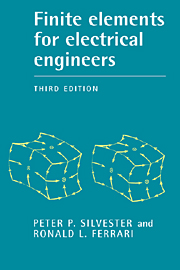Book contents
- Frontmatter
- Contents
- Preface to the third edition
- Preface to the first edition
- 1 Finite elements in one dimension
- 2 First-order triangular elements for potential problems
- 3 Electromagnetics of finite elements
- 4 Simplex elements for the scalar Helmholtz equation
- 5 Differential operators in ferromagnetic materials
- 6 Finite elements for integral operators
- 7 Curvilinear, vectorial and unbounded elements
- 8 Time and frequency domain problems in bounded systems
- 9 Unbounded radiation and scattering
- 10 Numerical solution of finite element equations
- Appendix 1 Calculations on simplex elements
- Appendix 2 Integration by parts, Green's theorems and Green's functions
- Appendix 3 Simplex element tables
- Appendix 4 Utility programs and style notes
- Appendix 5 Laboratory problems and exercises
- Index
Appendix 4 - Utility programs and style notes
Published online by Cambridge University Press: 05 June 2012
- Frontmatter
- Contents
- Preface to the third edition
- Preface to the first edition
- 1 Finite elements in one dimension
- 2 First-order triangular elements for potential problems
- 3 Electromagnetics of finite elements
- 4 Simplex elements for the scalar Helmholtz equation
- 5 Differential operators in ferromagnetic materials
- 6 Finite elements for integral operators
- 7 Curvilinear, vectorial and unbounded elements
- 8 Time and frequency domain problems in bounded systems
- 9 Unbounded radiation and scattering
- 10 Numerical solution of finite element equations
- Appendix 1 Calculations on simplex elements
- Appendix 2 Integration by parts, Green's theorems and Green's functions
- Appendix 3 Simplex element tables
- Appendix 4 Utility programs and style notes
- Appendix 5 Laboratory problems and exercises
- Index
Summary
Introduction
This Appendix lists several generally useful subprograms for matrix manipulation. It also clarifies some points of programming style as followed throughout this book. Most of the subprograms have no particularly close association with the material of any one chapter, but they are called upon to perform necessary services by programs listed in the several chapters. It therefore seems appropriate to group them in a single listing.
Input-data arrangements
Nearly all the programs in this book accept input data in roughly similar formats. Typically, a list of nodes is followed by a list of elements, which is in turn followed by a list of constraints. The lists are separated by lines blank except for a slant character / in the leading character position. This technique is based on the special meaning Fortran 77 assigns to the / character in list-directed input-output. It leads to program constructs a little different from C, Pascal, or many other languages, and therefore merits a brief discussion.
List-directed input–output is free-format. Numbers may be placed anywhere on the line, only their sequence need be correct. When input is requested, as many full lines are read in as is necessary to ensure that the input list has been fully satisfied, even if that means reading several lines. Since Fortran read statements always read full lines, a blank line will not be visible at all.
- Type
- Chapter
- Information
- Finite Elements for Electrical Engineers , pp. 472 - 477Publisher: Cambridge University PressPrint publication year: 1996

